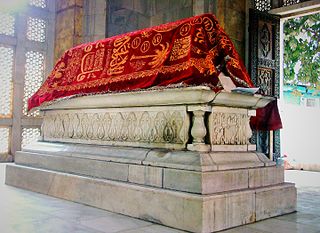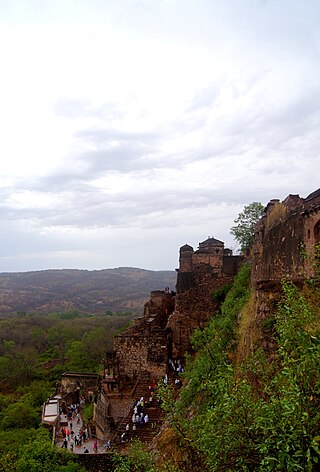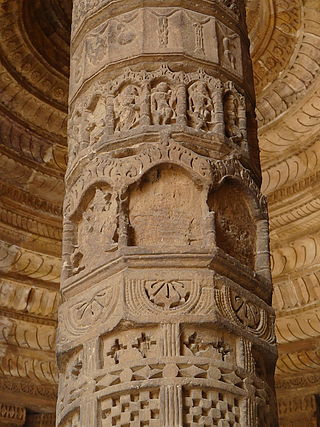Related Research Articles

Qutb ud-Din Aibak, was a general of the Ghurid emperor Muhammad Ghori. He was in charge of the Ghurid territories in northern India, and after Muhammad Ghori's assassination in 1206, he established the Delhi Sultanate (1206–1526), and started the Mamluk dynasty, which would rule the Sultanate until 1290.

Chauhan, a name derived from the historical Chahamanas, a clan name associated with various ruling Rajput families in the present-day Indian state of Rajasthan from seventh century onwards.

Prithviraja III, popularly known as Prithviraj Chauhan or Rai Pithora, was a king from the Chauhan (Chahamana) dynasty who ruled the territory of Sapadalaksha, with his capital at Ajmer in present-day Rajasthan. Ascending the throne as a minor in 1177 CE, Prithviraj inherited a kingdom which stretched from Thanesar in the north to Jahazpur (Mewar) in the south, which he aimed to expand by military actions against neighbouring kingdoms, most notably defeating the Chandelas.

Jalal-ud-Din Khalji, also known as Firuz al-Din Khalji or Jalaluddin Khilji was the founder and first Sultan of the Khalji dynasty that ruled the Delhi Sultanate from 1290 to 1320.

Hammiradeva was the last ruler from the Ranthambore branch of the Chauhans (Chahamanas). He is also known as Hamir Dev Chauhan in the Muslim chronicles and the vernacular literature.
Maharana Hammir Singh (1302–1364), or Hammir, was a 14th-century ruler of Mewar in present-day Rajasthan, India. Hammir Singh, was a scion of the cadet branch Rana of the Guhila dynasty, who regained control of the region, re-established the dynasty after defeating the Tughlaq dynasty, and captured present-day Rajasthan from Muslim forces of Delhi and became the first of the 'Rana' branch to become the King of Mewar with title of Maharana. Hammir also became the progenitor of the Sisodia clan, a branch of the Guhila dynasty, to which every succeeding Maharana of Mewar has belonged.
Kanhadadeva was a king belonging to the Chahamana dynasty, who ruled the area around Javalipura. Initially, he ran the administration jointly with his father Samantasimha, and helped ward off invasions from the Delhi Sultanate.

Ratnasimha was a ruler of the Medapata (Mewar) kingdom in present-day Rajasthan, India. He belonged to the Rawal branch of the Guhila dynasty, which ruled from the Chitrakuta fort. The last ruler of this branch, he was defeated by Alauddin Khalji during the Siege of Chittorgarh in 1303 CE.

Ranthambore Fort lies within the Ranthambore National Park, near the city of Sawai Madhopur in Sawai Madhopur district of Rajasthan, India. the park being the former hunting grounds of the Maharajahs of Jaipur until the time of India's Independence. It is a formidable fort having been a focal point of the historical developments of Rajasthan. The fort is believed to be constructed by numerous kings from Several Dynasties including Yadav lineage ,Chahamana Rajputs, Hada Rajputs, Mewar Rajput Kings and then the Delhi Sultanate captured it for a brief time. The fort provides a panoramic view of the surrounding Ranthambore National Park and is now a popular tourist attraction.

Harakeli Nataka is a Sanskrit drama written by the Chahamana (Chauhan) king Vigraharaja IV alias Visaladeva, who ruled from 1150 to 1164 CE. This drama is based on Kiratarjuniya of writer Bharavi.The play is also called Lalita Vigraharaja Nataka.
Almas Beg, better known by his title Ulugh Khan, was a brother and a general of the Delhi Sultanate ruler Alauddin Khalji. He held the iqta' of Bayana in present-day India.

The Chahamanas of Shakambhari, colloquially known as the Chauhans of Sambhar or Chauhans of Ajmer, were an Indian dynasty that ruled parts of the present-day Rajasthan and neighbouring areas in India, between the 6th and 12th centuries. The territory ruled by them was known as Sapadalaksha. They were the most prominent ruling family of the Chahamana (Chauhan) Rajput clan.

The Chahamanas of Ranastambhapura were a 13th-century Indian dynasty. They ruled the area around their capital Ranastambhapura (Ranthambore) in present-day Rajasthan, initially as vassals of the Delhi Sultanate, and later gained independence. They belonged to the Chahamana (Chauhan) clan of the Rajputs, and are also known as Chauhans of Ranthambore in vernacular Rajasthani bardic literature.
Hariraja was a king from the Chahamana (Chauhan) dynasty who ruled parts of his ancestral kingdom for a brief period, before being defeated by the Ghurids. After the Ghurid invaders defeated his brother Prithviraja III in 1192 CE, he dethroned his nephew Govindaraja IV, who had been appointed as a vassal ruler by the Ghurids.
Hammira Mahakavya is a 15th-century Indian Sanskrit epic poem written by the Jain scholar Nayachandra Suri. It is a legendary biography of the 13th century Chahamana king Hammira. While not entirely accurate from a historical point-of-view, the text provides valuable information about the medieval history of north-western India.
Alauddin Khalji's conquest of Gujarat, also known as the Muslim Conquest of Gujarat, began in 1299 when the Delhi Sultanate ruler Alauddin Khalji sent an army to ransack the Gujarat region of India, which was ruled by the Vaghela king Karna. The Delhi forces plundered several major cities of Gujarat, including Anahilavada (Patan), Khambhat, Surat and Somnath. Karna was able to regain control of at least a part of his kingdom in the later years. However, in 1304, a second invasion by Alauddin's forces permanently ended the Vaghela dynasty, and resulted in the annexation of Gujarat to the Delhi Sultanate.

In 1301, Alauddin Khalji, the ruler of the Delhi Sultanate in India, conquered the neighbouring kingdom of Ranastambhapura.
In 1311 Delhi Sultanate ruler Alauddin Khalji dispatched an army to capture the Jalore Fort in present-day Rajasthan, India. Jalore was ruled by the Chahamana ruler Kanhadadeva, whose armies had earlier fought several skirmishes with the Delhi forces, especially since Alauddin's conquest of the neighboring Siwana fort.

Trinetra Ganesh Temple is located in the Ranthambore fort within the Ranthambore National Park at a height of 1579 feet, near the city of Sawai Madhopur in Sawai Madhopur district of Rajasthan, India. People from different parts of eastern Rajasthan and all over the world come for darshan, to pray. On the occasion of Ganesh Chaturthi nearby villagers visit this temple, as their belief in this temple dates back more than 700 years. It is famous for its letter-like invitations sent during auspicious work and for resolving problems. Thousands of invitations and letters arrive daily, claiming that the heart's desires are fulfilled at this sacred location.
References
- ↑ Siba Pada Sen 1979, p. 129.
- 1 2 Aditya Malik 2021, p. 54.
- ↑ Aditya Malik 2021, pp. 54–56.
- 1 2 Aditya Malik 2021, p. 56.
- ↑ Aditya Malik 2021, p. 118.
- ↑ Aditya Malik 2021, p. 55.
- ↑ Aditya Malik 2021, pp. 56, 63–64.
- ↑ Aditya Malik 2021, p. 65.
- ↑ Aditya Malik 2021, pp. 65–66.
- ↑ Aditya Malik 2021, pp. 67–68.
- ↑ B. Bandyapadhyaya 1879, p. 199.
- ↑ B. Bandyapadhyaya 1879, pp. 198–204.
- ↑ B. Bandyapadhyaya 1879, pp. 206–222.
- ↑ B. Bandyapadhyaya 1879, pp. 222–225.
- ↑ B. Bandyapadhyaya 1879, pp. 222–229.
- ↑ B. Bandyapadhyaya 1879, p. 227.
- ↑ B. Bandyapadhyaya 1879, pp. 242–245.
- ↑ B. Bandyapadhyaya 1879, pp. 242–247.
- ↑ Jitamitra Prasad Singh Deo 1987, p. 121.
- ↑ Dasharatha Sharma 1959, p. 107.
- ↑ James Sadler Hamilton 1989, p. 62.
Bibliography
- Aditya Malik (2021). Hammīra: Chapters in Imagination, Time, History. Religion and Society. Vol. 83. De Gruyter. ISBN 978-3-11-065959-7.
- Brajnath Bandyapadhyaya. "Hamir Rasa or a History of Hamir, Prince of Ranthambore". The Journal of the Asiatic Society of Bengal (48): 186–252.
- Dasharatha Sharma (1959). Early Chauhān Dynasties. S. Chand / Motilal Banarsidass. ISBN 9780842606189.
- James Sadler Hamilton (1989). Sitar Music in Calcutta. Publisher:Motilal Banarsidass. ISBN 9788120812109.
- Jitamitra Prasad Singh Deo (1987). Archaeology of Orissa: with special reference to Nuapada and Kalahandi. R.N. Bhattacharya. ISBN 9788121200950.
- Siba Pada Sen, ed. (1979). Historical Biography in Indian Literature. Institute of Historical Studies.